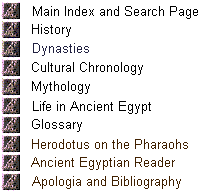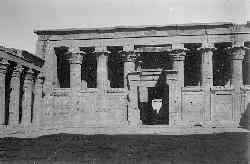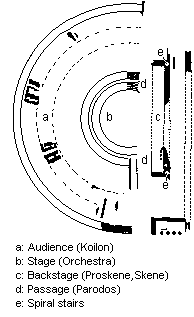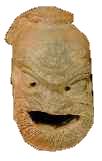
The ancient Egyptian theatre
The Greeks may have believed that they were the inventors of theatre, but apparently the Egyptians, while they did not construct special venues for their plays, preceded them in the performance of shows, which were mostly pageant-like, religious in character, ritualistic and to a large extent devoid of drama.
The Ramesseum Dramatic Papyrus (published by Kurt Sethe, 1928) written seemingly by the master of ceremonies is an account of the coronation of Senusret I and contains among other things the words spoken by the actors representing the various gods.
One of the texts accompanying temple reliefs at Edfu describes aspects of a New Kingdom
 religious drama performed during the Horus festival while the statue of Hathor was carried from her temple at Denderah to the festivities at Edfu.
religious drama performed during the Horus festival while the statue of Hathor was carried from her temple at Denderah to the festivities at Edfu.
Horus temple at Edfu
Source: University of Erlangen website
According to accounts Seth, represented by a live hippopotamus, was killed on stage by a priest or even by the king himself in the role of Horus. The final annihilation of Seth occurred when a hippopotamus cake was carved up and eaten.
Other texts were somewhat like morality plays with psychological aspects, Isis and the seven scorpions for instance, where gods were treated like humans. These were written in verse and required choruses.
According to Blackman and Fairman the Creation Drama was performed in the temple. Nothing is known about the exact place and time. Probably the event was annual taking place during the Horus festivals on the shore of the holy lake.
Religious plays
The murder of Osiris by Seth, his dismemberment and resuscitation made for excellent theatre and was frequently shown, with the main roles played by professional actors and the extras often members of the public. Abydos and Busiris were important centres for these activities.The festivities were divided into three parts: the defense of Osiris by his son Upuaut, the fight of Osiris himself and his demise, and lastly the triumph of Osiris when his enemies are defeated.
Also at Sais there is the burial-place of him whom I account it not pious to name in connexion with such a matter, which is in the temple of Athene behind the house of the goddess, stretching along the whole wall of it; and in the sacred enclosure stand great obelisks of stone, and near them is a lake adorned with an edging of stone and fairly made in a circle, being in size, as it seemed to me, equal to that which is called the "Round Pool" in Delos. On this lake they perform by night the show of his sufferings, and this the Egyptians call Mysteries.Ikhernofret [2], a pilgrim to Abydos described his experience:Herodotus, Histories II
Project Gutenberg
I celebrated the Procession of Upwauet when he proceeded to champion his father...I repulsed those who were hostile to the Neshmet barque, and I overthrew the enemies of Osiris...I followed the god in his footsteps...I sailed the divine barque...I equipped the barque called Shining in Truth of the Lord of Abydos with a chapel...I led the god to his tomb...I championed Osiris on that Day of the Great Battle, overthrowing all the enemies on the shore of Nedyt...I caused him to proceed to the barque, and it bore the beauty of Osiris...I gladdened the heart of the eastern highlands and knew the jubilation of the western highlands when they saw the beauty of Osiris upon the barque...the barque landed at Abydos and we brought Osiris, First of the Westerners, Lord of Abydos to his palace...I walked with Osiris.The involvement of the public was at times frighteningly enthusiastic
... at Papremis they do sacrifice and worship as elsewhere, and besides that, when the sun begins to go down while some few of the priests are occupied with the image of the god, the greater number of them stand in the entrance of the temple with wooden clubs, and other persons to the number of more than a thousand men with purpose to perform a vow, these also having all of them staves of wood, stand in a body opposite to those: and the image, which is in a small shrine of wood covered over with gold, they take out on the day before to another sacred building.Juvenal [1] was witness to similar displays at Ombus in Upper Egypt and commented on the perceived enmity between Ombus and Denderah, how the inhabitants of one town would disrupt the celebrations of the other. There were fist fights at first, then stones were thrown and at last arrows shot. The fleeing inhabitants of Denderah left behind one of theirs, who was cut to pieces and devoured - probably a slight exaggeration on behalf of the writer.
The few then who have been left about the image, draw a wain with four wheels, which bears the shrine and the image that is within the shrine, and the other priests standing in the gateway try to prevent it from entering, and the men who are under a vow come to the assistance of the god and strike them, while the others defend themselves. Then there comes to be a hard fight with staves, and they break one another's heads, and I am of opinion that many even die of the wounds they receive; the Egyptians however told me that no one died.
This solemn assembly the people of the place say that they established for the following reason:--the mother of Ares, they say, used to dwell in this temple, and Ares, having been brought up away from her, when he grew up came thither desiring to visit his mother, and the attendants of his mother's temple, not having seen him before, did not permit him to pass in, but kept him away; and he brought men to help him from another city and handled roughly the attendants of the temple, and entered to visit his mother. Hence, they say, this exchange of blows has become the custom in honour of Ares upon his festival.Herodotus, Histories II
Project Gutenberg
Ihy was the son of Hathor and Horus or Re. The birth of the child god was celebrated with annual festivals at the major temples dedicated to triads. This tradition may have been the development of the recounting of the birth and coming into power of the new pharaoh which was used to legitimise his rule. With the decay of the indigenous kingship in the first millennium BCE, the hopes for a legitimate and just rule in this world were transferred into the realm of the divine. These performances may have had little dramatic content and could possibly be classified as happenings.
Satires
Local myths supplied story lines for many plays which often had satirical overtones: The pharaoh received five hundred lashes, his wives deceived him, he couldn't make up his mind and became a slave to his advisors; and his architects robbed his wealth.
The gods did not fare any better in these plays: For twenty four years the council of gods deliberated about who should inherit Osiris - Seth or Horus. The debauchery of Seth was equal only to his stupidity and Horus wept like a baby on being beaten. Hathor, when called before the creator, dropped her clothes to show how little she valued his decisions.
While this is not theatre in our sense, it is certainly dramatic dialogue, funny and at times bawdy, which was probably recited before audiences:
After a considerable while Hathor, Lady of the Southern Sycamore, came and stood before her father, the Universal Lord, and she exposed her vagina before his very eyes. Thereupon the great god laughed at her. Then he got right up and sat down with the Great Ennead. He said to Horus and Seth: "Speak concerning yourselves."
Seth, great in virility, the son of Nut, said: "As for me, I am Seth, greatest in virility among (the) Ennead, for I slay the opponent of Pre daily while I am at the prow of the Bark of the Millions, whereas not any (other) god is able to do it. I should receive the office of Osiris."
Then they said: "Seth, the son of Nut, is correct."
Onuris and Thoth let out a loud cry, saying: "Is it while a bodily son is still living that the office is to be awarded to a maternal uncle?"
Then said Banebdjede, the living great god: "Is it while Seth, his elder brother, is still living that the office is to be awarded to the (mere) lad?"
The contendings of Horus and Seth
Chester Beatty papyrus I
The Graeco-Roman period
 The Greek colonists brought with them their own theatrical traditions, which were part of the cult of Dionysos. Under the Ptolemies some regions of Egypt became quite hellenized, most famously parts of the western Delta and the Fayum, and the settlers followed the customs of their forefathers, little influenced by native Egyptian usages.
The Greek colonists brought with them their own theatrical traditions, which were part of the cult of Dionysos. Under the Ptolemies some regions of Egypt became quite hellenized, most famously parts of the western Delta and the Fayum, and the settlers followed the customs of their forefathers, little influenced by native Egyptian usages.
Plan of the Roman theatre at Oxyrhynchos
After W.M.F. Petrie Tombs of the Courtiers and Oxyrhynkhos

New Comedy mask made of terracotta
Source: Petrie Museum website [3]
[1] Juvenal Decimus Junius Juvenalis, a Roman poet who lived from about 58 to 140 , wrote five books of satirical hexameters, in which he criticised human frailties and vices.